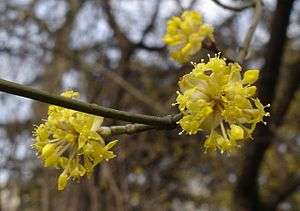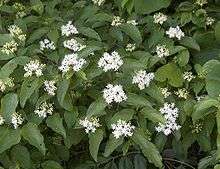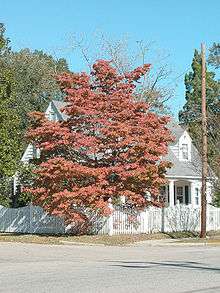| Dogwoods | |
|---|---|
 | |
| Genus: | Cornus |
| Family: | Cornaceae |
| Type: | Trees and Shrubs |
| Disease issues: | Some serious |
| Pollination: | Insect |
The Dogwoods comprise a group of 30-50 species of deciduous woody plants (shrubs and trees) in the family Cornaceae, divided into one to nine genera or subgenera (depending on botanical interpretation). Four subgenera are enumerated here.
Most species have opposite leaves, but alternate in a few. The fruit of all species is a drupe with one or two seeds. Flowers have four parts.
Many species in subgenus Swida are stoloniferous shrubs, growing along waterways. Several of these are used for naturalizing landscape plantings, especially the species with bright red or bright yellow stems. Most of the species in subgenus Benthamidia are small trees used as ornamental plants.
The name 'dogwood' is a corruption of 'dagwood', from the use of the slender stems of very hard wood for making 'dags' (daggers, skewers). The wood was also highly prized for making the shuttles of looms, for tool handles, and other small items that required a very hard and strong wood.
The fruit of several species in the subgenera Cornus and Benthamidia is edible, though without much flavour. The berries of those in subgenus Swida are mildly toxic to people, though readily eaten by birds.
Popular legend has it that wood from the dogwood was used to construct the cross on which Christ was crucified. God had pity upon the tree, giving it white flowers similar to the cross. The reddish center of each flower symbolizes the blood of Christ. God transformed the once towering tree into one that is small with twisted, gnarled trunks so they could never be used for the purpose of building a cross again. The term dogwood winter may be used to describe a cold snap in spring.
Description
Growing conditions
Species


- Flower clusters semi-showy, usually white or yellow, in cymes without large showy bracts, fruit red, blue or white:
- (Sub)genus Cornus. Cornels; four species of shrubs or small trees; flower clusters with a deciduous involucre.
- Cornus chinensis (Chinese Cornel). China.
- Cornus mas (European Cornel or Cornelian-cherry). Mediterranean.
- Cornus officinalis (Japanese Cornel). Japan.
- Cornus sessilis (Blackfruit Cornel). California.
- (Sub)genus Swida. Dogwoods; about 20-30 species of shrubs; flower clusters without an involucre.
- Cornus alba (Swida alba; Siberian Dogwood). Siberia and northern China.
- Cornus alternifolia (Swida alternifolia; Pagoda Dogwood or Alternate-leaf Dogwood). Eastern North America north to extreme southeast Canada.
- Cornus amomum (Swida amomum; Silky Dogwood). Eastern U.S. east of the Great Plains except for deep south, and extreme southeast Canada.
- Cornus asperifolia (Swida asperifolia; Rough-leaf Dogwood).
- Cornus austrosinensis (Swida austrosinensis; South China Dogwood). East Asia.
- Cornus bretschneideri (Swida bretschneideri; Bretschneider's Dogwood). Northern China.
- Cornus controversa (Swida controversa; Table Dogwood). East Asia.
- Cornus coreana (Swida coreana; Korean Dogwood). Northeast Asia.
- Cornus drummondii (Swida drummondii; Roughleaf Dogwood). U.S. between the Appalachian belt and the Great Plains, and southern Ontario.
- Cornus glabrata (Swida glabrata; Brown Dogwood or Smooth Dogwood). Western North America.
- Cornus hemsleyi (Swida hemsleyi; Hemsley's Dogwood). Southwest China.
- Cornus koehneana (Swida koehneana; Koehne's Dogwood). Southwest China.
- Cornus macrophylla (Swida macrophylla; Large-leafed Dogwood). East Asia.
- Cornus obliqua (Swida obliqua; Pale Dogwood). Eastern North America.
- Cornus paucinervis (Swida paucinervis). China.
- Cornus racemosa (Swida racemosa; Northern Swamp Dogwood or Gray Dogwood). Extreme southeast Canada and northeast U.S.
- Cornus rugosa (Swida rugosa; Round-leaf Dogwood). Southeast Canada and extreme northeast U.S.
- Cornus sanguinea (Swida sanguinea; Common Dogwood). Europe.
- Cornus sericea (C. stolonifera; Swida stolonifera; Red Osier Dogwood). Northern North America.
- Cornus stricta (Swida stricta; Southern Swamp Dogwood). Southeast U.S.
- Cornus walteri (Swida walteri; Walter's Dogwood). Central China.
- Cornus wilsoniana (Swida wilsoniana; Wilson's Dogwood). Central China.
- (Sub)genus Cornus. Cornels; four species of shrubs or small trees; flower clusters with a deciduous involucre.
- Flower clusters inconspicuous, usually greenish, surrounded by large, showy petal-like bracts; fruit usually red:
- (Sub)genus Chamaepericlymenum. Bunchberries or Dwarf cornels; two species of creeping subshrubs growing from woody stolons.
- Cornus canadensis (Chamaepericlymenum canadense; Canadian Dwarf Cornel or Bunchberry) Northern North America.
- Cornus suecica (Chamaepericlymenum suecicum; Eurasian Dwarf Cornel or Bunchberry). Northern Eurasia, locally in extreme northeast and northwest North America.
- Cornus × unalaschkensis (hybrid C. canadensis × C. suecica). Aleutian Islands, Greenland, Labrador.
- (Sub)genus Benthamidia (syn. subgenus Dendrobenthamia, subgenus Cynoxylon). Flowering dogwoods; five species of trees.
- Cornus capitata (Benthamidia capitata; Himalayan Flowering Dogwood). Himalaya.
- Cornus florida (Benthamidia florida; Flowering Dogwood). U.S. east of the Great Plains, north to southern Ontario.
- Cornus hongkongensis (Benthamidia hongkongensis; Hong Kong Dogwood). Southern China, Laos, Vietnam.
- Cornus kousa (Benthamidia kousa; Kousa Dogwood). Japan and (as subsp. chinensis) central and northern China.
- Cornus nuttallii (Benthamidia nuttallii; Pacific Dogwood). Western North America from British Columbia to California.
- (Sub)genus Chamaepericlymenum. Bunchberries or Dwarf cornels; two species of creeping subshrubs growing from woody stolons.
Uses
Maintenance
Propagation
Harvest
Pests and Diseases
w:Emperor Moth, The Engrailed, w:Small Angle Shades and the following case-bearers of the genus
Coleophora: C. ahenella, C. salicivorella (recorded on Cornus canadensis), C. albiantennaella, C. cornella and C. cornivorella (The latter three feed exclusively on Cornus).
- Melon Aphid: Aphis gossypii
- Sunflower Aphid
- Calico Scale: Eulecanium cerasorum
- European Fruit Lecanium Scale: Lecanium corni
- Oystershell Scale: Lepidosaphes ulmi
- Obscure Scale: Melanaspis obscura
- Gloomy Scale: Melanaspis tenebricosa
- Cottony Maple Scale: Pulvinaria innumerabilis
- Walnut Scale: Quadraspidiotus juglansregiae
- San Jose Scale: Quadraspidiotus perniciosus
- Cottony Maple Leaf Scale: Pulvinaria innumerabilis
- Dogwood Scale: Chionaspis corni
- Forbes Scale
- Horse Chestnut Scale: Pulvinaria regalis
- Japanese Maple Scale
- Tea Scale: Fiorina theae
- Thorn Scale
- Leafhopper: Edwardsiana commisuralis
- Rose Leafhopper: Edwardsiana rosa
- Mulberry Whitefly: Tetraleurodes mori
- Striped Mealybug
- Taxus Mealybug: Dysmicoccus wistariae
Bugs:
- Alder Spittlebug: Clastoptera obtusa
- Fourlined Plant Bug: Poecilocapsus lineatus
- Basswood Lace Bug
- Western Conifer Seed Bug
- Dogwood Club Gall Midge: Mycodiplosis clavula
- Flatheaded Apple Tree Borer: Chrysobothris femorata
- Raspberry Cane Borer: Oberea bimaculata
- Dogwood Twig Borer: Oberea tripunctata
- Twig Gridler: Oncideres cingulata
- Locust Leaf Miner: Xenocephalus dorsalis
- Asian Ambrosia Beetle
- Pitted Ambrosia Beetle: Corthylus punctatissimus
- Redheaded Flea Beetle: Systena frontalis
- Japanese Weevil: Callirhopalis bifasciatus
- Asiatic Oak Weevil: Cyrtepistomus castaneus
- Gypsy Moth Caterpillar: Lymantria dispar
- Dogwood Borer: Synanthedon scitula
- Cecropia Moth: Hyalophora cecropia
- Polyphemus Moth: Antheraea polyphemus
- Red Humped Caterpillar: Schizura concinna
- Emperor Moth: Pavonia pavonia
- Engrailed Moth: Ectropis crepuscularia
- Small Angle Shades Moth: Euplexia lucipara
- Unicorn Caterpillar
- Dogwood Sawfly
- Giant Hornet: Vespa crabro germana
- Twospotted Spider Mite: Tetranychus urticae
References
- Britton, Nathaniel Lord; Addison Brown (1913). An Illustrated Flora of the Northern United States and Canada, Volume 1 (second edition ed.). Dover Publications, inc.. pp. 660–665.
- Ann Fowler Rhoads and Timothy A. Block (2000). The Plants of Pennsylvania: An Illustrated Manual. Anna Anisko, illustrator. Morris Arboretum, University of Pennsylvania Press. pp. 362–365.
- Christopher Brickell and Judith D. Zuk (1997). The American Horticultural Society A-Z Encyclopedia of Garden Plants. DK Publishing. pp. 297–300.
- Pirone, Pascal P.. Diseases & Pests of Ornamental Plants. pp. 210–213.
- Cranshaw, Whitney (2004). Garden Insects of North America. Princeton University Press. pp. 589.